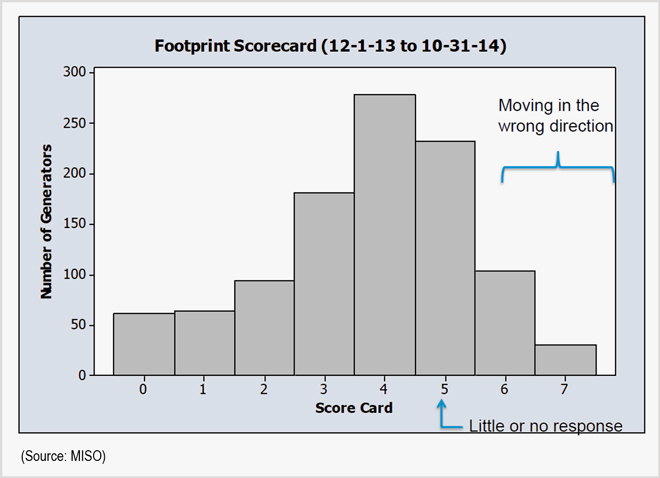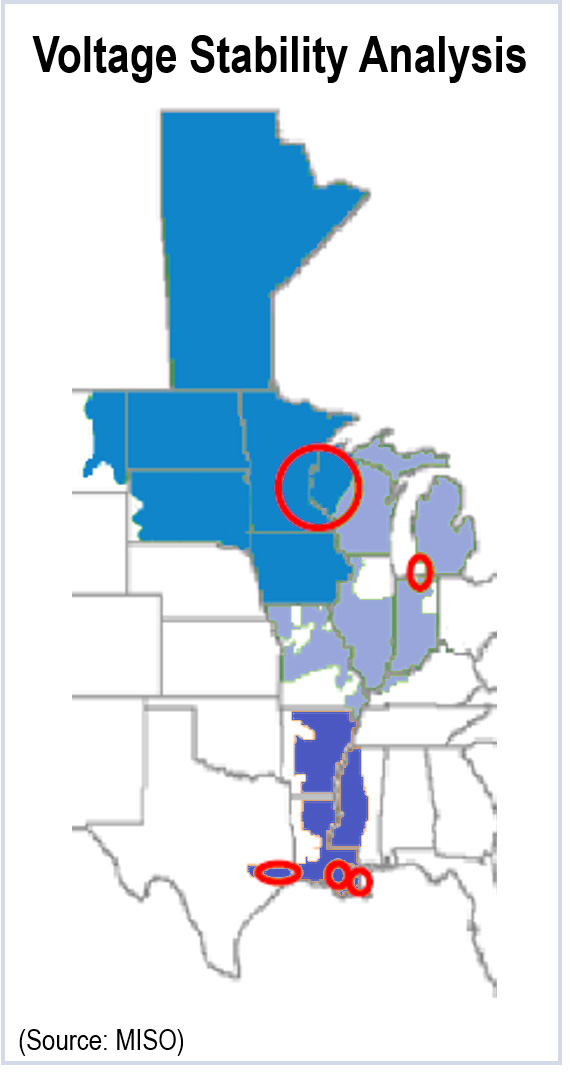CARMEL, IND. — MISO has begun collecting data from local balancing authorities in preparation for the North American Electric Reliability Corp.’s new frequency response standard (BAL-003-1).
NERC’s rule is intended to ensure sufficient frequency response from balancing authorities to control interconnection frequency. It also sets consistent methods for measuring frequency response and determining frequency bias settings.
The “generator scorecards” that LBAs are completing cover the period Dec. 1, 2013, through Oct. 31, 2014. MISO’s Terry Bilke presented the results to date to the Reliability Subcommittee, including a histogram showing generator results on a scale of zero to seven. (See chart.) “Anything five and above is problematic,” he said.
Bilke said MISO will work with LBAs and generators to boost governor response where necessary.
The standard was approved by the Federal Energy Regulatory Commission in January 2014. (See FERC OKs Rules on Geomagnetic Disturbances, Frequency Response.)
The frequency bias setting requirement takes effect April 1. By April 1, 2016, balancing authorities will be required to achieve an annual frequency response measure (FRM) “equal to or more negative” than its frequency response obligation.
Operations Working Group Charter, Management Plan OK’d
Members endorsed the 2015 charter and management plan for the Operations Working Group. There were no substantive changes from 2014, according to chair Ray McCausland of Ameren.
MISO Readies for GMD Rule
Alliant’s Will Behnke, chair of the Emergency Preparedness / Power System Restoration Working Group, briefed members on MISO’s preparation for NERC’s Geomagnetic Disturbance Operations Standard (EOP-010-1), which takes effect April 1.
“We’re ready,” Behnke said.
The standard requires Reliability Coordinators to review the geomagnetic disturbance (GMD) operating procedures or processes of transmission operators (TOPs) within their areas to mitigate the effect of GMDs on the grid.
TOPs must submit a worksheet to MISO 30 days before their GMD operating procedure becomes effective or is revised.
FERC approved the standard, the first phase of rules to protect the grid from GMDs, in June. (See FERC OKs GMD, Training Standards; Proposes Modeling Rule Change.)
Performance on Real-Time Operations Drills Improving
Local balancing authorities and market participants have improved their performance on monthly drills of real-time operations processes, with more than 80% successfully completing them, MISO’s Danielle Logsdon told members.
Logsdon said that is a marked improvement from the prior success rate of 60%. Performance on the XML drill is “close to 100%,” Logsdon said.
Distributed ICCP Project Extended
MISO said it doesn’t expect to complete its distributed ICCP project until the first quarter of 2016.
MISO’s Arijit Bhowmik told members the RTO expects to complete migration of 70% of the internal links to the new systems by the end of this year. The project, announced last year, was originally scheduled to be complete this August.
ICCP (Inter-Control Center Communications Protocol) is MISO’s real-time data source, providing visibility into the grid and allowing four-second dispatch of generation. The project will spread members across multiple ICCP nodes, reducing the impact of a single failure.
Summer Seasonal Assessment Takes a Closer Look at Louisiana
The 2015 Summer Coordinated Seasonal Transmission Assessment will include a reactive reserves analysis of the Baton Rouge area for the first time, MISO’s Scott Goodwin told members.
Also new will be a voltage stability analysis for the Amite South HV Interface and Southwest Michigan imports.
The CSA is intended to inform operators of potential marginal system conditions expected during the upcoming summer peak and evaluate various stressed conditions, including second contingencies.
The analysis will begin this month, with a draft report posted for review April 24 and the final report expected May 29.




